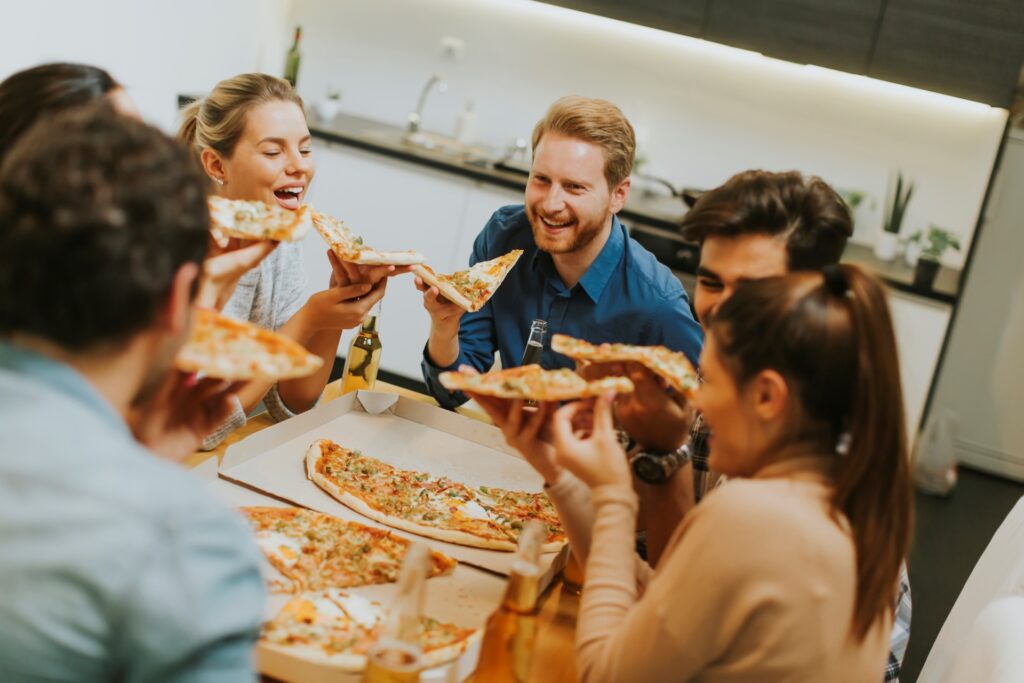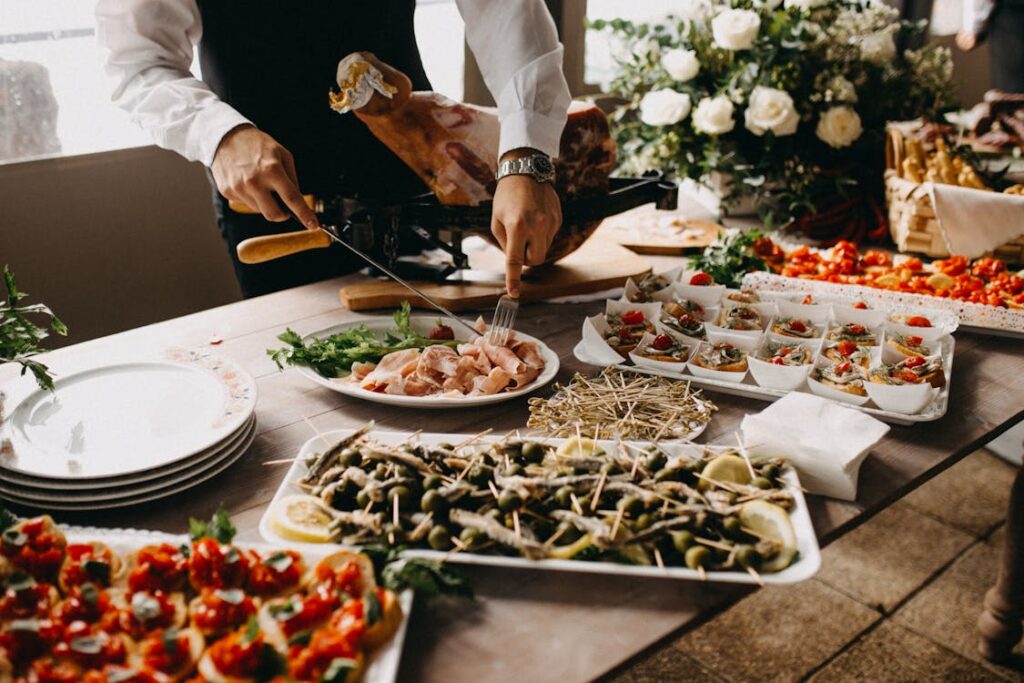In event hospitality, catering is no longer an exercise in logistical function but a culinary performance art. From celebrity chef events to major university assemblies, the demands around mass catering have changed far beyond the side requirements of just feeding a crowd. Today’s customers want not just food but also performance plating that displays luxury, flavors that tell a story, and service that glides with smoothness.
While demand for experiential culinary events grows, people search for event catering tips. This blog delves into the subtleties and art of offering world-class catering where every detail, from the presentation on the plate to the after-dinner logistics, must operate in orchestrated finesse.
The High Stakes of Large-Scale Catering
Catering on the move is akin to leading a finely tuned symphonic performance. As the number of visitors increases, the leeway becomes less. The stakes are higher: not only does the culinary tale need to remain true throughout many thousands of dishes, but the emotional impact of the event depends on this general perfection.
A large-scale catering project calls for all parts to be coordinated: the acquisition of fresh, top-quality components; the scheduling of cooking times; the flexible building of the catering menu; and the seamless front-of-house service integration. Any of these lapse in judgment adds to the most usual catering errors and how to avoid them—a subject that underscores the importance of proactive measures against top mistakes.
Read this detailed report to uncover the reality of high-volume catering.
Catering Planning: From Blueprint to Banquet
Venue Infrastructure and Flow Dynamics
Before menu engineering, the physical environment has to be well-planned for efficiency. A high-end caterer has to perform a spatial audit—checking kitchen access, electrical load, waste systems, and service corridors. Event planners underestimate the connection between venue layout and guest experience, one of the most underestimated top 10 catering errors. Properly zoned prep stations, plating lines, and serving stations will assure rhythm and flow.
Scalable Culinary Execution
Mass production of gourmet cuisine to the thousands demands strategic levels of production—bulk preparation, staging, finishing, and plating. From the kitchen to the guests, every meal should be consistent in itself. Catering calls for culinary choreography, whereby timing and sequence are just as critical as flavor and texture, quite unlike conventional food service.
Synchronized Beverage Architecture
A frequently underappreciated element, beverage pairing needs to be integrated with food service in order to keep the momentum going. A well-crafted catering menu includes not just courses and appetizers but also wine lists incorporated therein, hand-made artisanal mocktails, and smart hydration techniques. In addition to this event, the design must include beverage stations, mixology counters, and sommelier services.
The Art of Designing a Strategic Catering Menu

Developing a catering menu for large events is not a numbers game—it’s an exercise in cultural and culinary diplomacy. Today’s guest demands story gastronomy. Menus must transform through courses: from regionally sourced canapés to globally inspired fusion entrées and playful, sense-driven desserts. Dietary needs—gluten-free, keto, vegan, low-FODMAP—are no longer optional, but de rigueur.
Portion scaling, flavor sequencing, and visual architecture should be core principles. A well-designed catering menu reduces prep duplication, minimizes the risk of cross-contamination, and simplifies service flow—all while preserving the creativity of a boutique culinary experience.
Menu Simulations and Mock Service Trials
Among the top event catering tips is performing stress simulations—mocking full-service set-ups in real-time conditions. Such a pre-event dry run uncovers hidden flaws in prep cycles, portioning precision, and plate integrity.
Designating a Guest Experience Facilitator
Integrate a designated liaison whose specific function is guest comments, allergen control, and on-the-ground problem-solving. This new addition maximizes guest satisfaction and shows a top-notch service vision.
Tech-Enabled Waste Intelligence
Utilize artificial intelligence-driven portion forecasting software to match prep levels with real consumption data. This not only maximizes yield, but it reduces food waste—arguably the most under-estimated common catering mistake, and how to prevent it.
Scaling Catering from 1,000 to 10,000: Strategic Insights
The delta between planning for 1,000 guests versus 10,000 isn’t linear, it’s exponential. Storage logistics, staff ratios, food safety redundancies, and service modularity need exponential scaling in planning architectures. Sophisticated catering planning needs real-time contingency modeling, food-grade logistics alliances, and intelligent tracking systems.
The distinction is in fine-grain orchestration—portion algorithms, scheduled food deployment, and inter-zonal service choreography. High-end catering requires institutional infrastructure at the expense of boutique aesthetics.
Top 10 Catering Mistakes: The Critical Pitfalls
The domain of catering is a meticulous intersection of gastronomic creativity, operational acumen, and experiential refinement. Nevertheless, even the most masterfully choreographed affairs are vulnerable to strategic errors. In order to safeguard gastronomic brilliance from succumbing to logistical errors, one must carefully identify—and systematically anticipate—the most widespread threats that can undermine an otherwise flawless experience. Following is an in-depth analysis of the top 10 catering errors, full of strategic vision and infused with cutting-edge hospitality wisdom.
- Inaccurate Portion Ratio Calibration per Capita – A fundamental sin of mass-scale catering is the inaccurate computation of portion allocations. Exaggerated assumptions result in unviable wastage and expense inflation, while minimalist assumptions trigger guest dissatisfaction and service derailment. Accuracy-based portion modeling and consumption analysis need to be pillars of your catering planning.
- Negligent Allergen Communication Procedures – Failure to adopt prominent allergen labeling on all food stations is not just a procedural lapse—it represents a serious health risk. The use of full allergen matrices and clear ingredient mapping is not discretionary—it is necessary to avoid the most harmful catering errors and maintain inclusivity in the catering menu.
- Disharmonic Front-of-House-to-Kitchen Coordination – A fragmented interrelation among dining and service groups results in slow service, substandard plate quality, and loss of guest engagement. Implementation of real-time communication systems and timing of service periods can avert such system failure in catering.
- Lack of Redundant Staff Infrastructure – Unpredictability of staffing is one of the most underrated threats. The lack of a multi-tiered contingency staffing model typically leads to the collapse of operations. Fore-beship deployment of spare personnel is an indispensable tactic in sophisticated catering planning.
- Inadequate Vendor Due Diligence and Verification – Sole-source vendor reliance is a risky bet. Cross-verification of supply chain dependability and the identification of backup procurement channels are indispensable to ensure smooth continuation. This is one of the most often disregarded but strategically harmful top gaffes in catering.
- Inadequate Thermal Control and Holding Procedures – Maintaining food integrity requires uncompromising thermal management. Temperature deviations not only damage sensory attractiveness but also pose serious health hazards. Upgrading to premium warming equipment and temperature monitoring is essential.
- Post-Service Sanitation and Recovery Logistics Neglect – Post-service operation closure is equally crucial to the event’s success. Inferior cleanup paradigms are detrimental to client perception and relations with the venue. Biodegradable waste inclusion and organized sanitation procedures are non-negotiable for event sustainability.
- Imbalanced Dietary Distribution in Menu Planning – A catering menu that is overloaded with high-carb items or protein deficiencies signifies poor menu planning. Healthy culinary presentation—balanced in texture, color, and flavor harmony—enhances both visual attractiveness and nutritional appropriateness.
- In-Situ Feedback Acquisition Mechanisms Deficiency – The lack of real-time feedback collection in the midst of live service represents a lost optimization opportunity. Enabling personnel to provide real-time feedback on guest sentiments drives anticipatory adjustments and increases the experiential aspect of catering (1k–10k).
- Shortage of Supply Chain Volatility Strategic Contingency – There is a precarious base in having a single source route. The resilience of an event is ensured by pre-written backup sourcing arrangements and logistic backup. This is one of the most insidious but avoidable common catering mishaps and their avoidance.
The Manny & Olga’s Operational Parallel
Manny & Olga’s, with its expansive culinary catalog and adaptable operational model,is a classic example of scalable food excellence. Our ability to cater mass-volume events with a blend of gourmet and comfort food options speaks to the benchmark of catering sophistication. From modular pizza platters to crowd-pleasing pasta trays, our products prove how simplicity, when carefully crafted, can be gourmet-elevated. Our meticulous delivery systems, real-time monitoring, and flexible menu templates have made us a top choice for caterer services for regional events.
So, whether you’re hiring an experienced caterer, putting together a detailed menu, or planning out your catering strategy for the next big event, there’s one thing you gotta remember—great catering isn’t just about how big it is. It’s really about the heart behind it.

Discover our exceptional catering options now and let us bring your idea to life with an experience nothing short of breathtaking. Let your experience be a culinary exploration with us!
